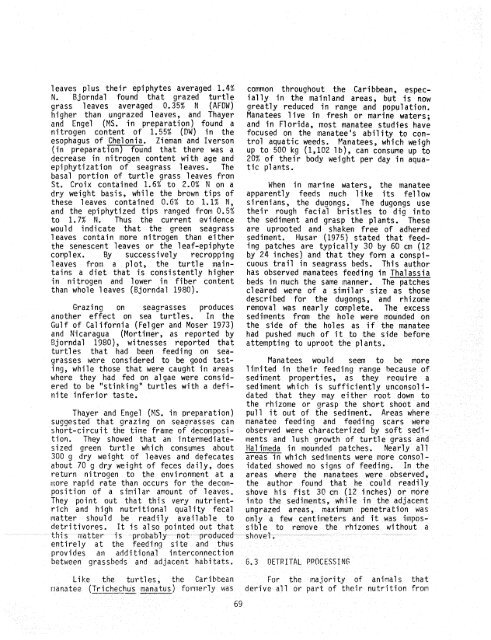The Ecology of the Seagrasses of South Florida - USGS National ...
The Ecology of the Seagrasses of South Florida - USGS National ...
The Ecology of the Seagrasses of South Florida - USGS National ...
You also want an ePaper? Increase the reach of your titles
YUMPU automatically turns print PDFs into web optimized ePapers that Google loves.
1 eaves pl us <strong>the</strong>ir epiphytes averaged 1.4%<br />
N. Bjorndal found that grazed turtle<br />
grass leaves averaged 0.35% N (AFDw)<br />
higher than ungrazed leaves, and Thayer<br />
and Engel (MS. in preparation) found a<br />
nitrogen content <strong>of</strong> 1.55% (DM) in <strong>the</strong><br />
esophagus <strong>of</strong> Chelonia. Zieman and Iverson<br />
(in preparat'found that <strong>the</strong>re was a<br />
decrease in nitrogen content with age and<br />
epiphytization <strong>of</strong> seagrass 1 eaves. <strong>The</strong><br />
basal portion <strong>of</strong> turtle grass leaves from<br />
St. Croix contained 1.6% to 2.0% N on a<br />
dry weight basis, while <strong>the</strong> brown tips <strong>of</strong><br />
<strong>the</strong>se leaves contained O.G% to 1.1% N,<br />
and <strong>the</strong> epiphytized tips ranged from 0.52<br />
to 1.7% N. Thus <strong>the</strong> current evidence<br />
would indicate that <strong>the</strong> green seagrass<br />
leaves contain more nitrogen than ei<strong>the</strong>r<br />
<strong>the</strong> senescent leaves or <strong>the</strong> leaf-epiphyte<br />
covpl ex. By successively recropping<br />
leaves from a plot, <strong>the</strong> turtle maintains<br />
a diet that is consistently higher<br />
in nitrogen and lower in fiber content<br />
than whole 1 eaves (6jorndal 1980).<br />
Grazing on seagrasses produces<br />
ano<strong>the</strong>r effect on sea turtles. In <strong>the</strong><br />
Gulf <strong>of</strong> California (Felger and Moser 1973)<br />
and Nicaragua (Mortimer, as reported by<br />
Bjorndal 1980), witnesses reported that<br />
turtles that had been feeding on seagrasses<br />
were considered to be good tasting,<br />
while those that were caught in areas<br />
where <strong>the</strong>y had fed on algae were considered<br />
to be "stinking" turtles with a defini<br />
te inferior taste.<br />
Thayer and Engel (gS. in preparation)<br />
suggested that grazing on seaorasses can<br />
short-circuit <strong>the</strong> time frame <strong>of</strong> decornposition.<br />
<strong>The</strong>y showed that an intermediatesized<br />
green turtle which consumes about<br />
300 g dry weight <strong>of</strong> leaves and defecates<br />
about 70 g dry weight <strong>of</strong> feces daily, does<br />
return nitrogen to <strong>the</strong> environment at a<br />
%ore rapid rate than occurs for <strong>the</strong> decomposition<br />
<strong>of</strong> a similar amount <strong>of</strong> leaves.<br />
<strong>The</strong>y point out that this very nutrientrich<br />
and high nutritional quality fecal<br />
matter should be readily available to<br />
tritivores. It is also pointed out that<br />
is matter is probably not prodaced<br />
entirely at <strong>the</strong> feeding site and thus<br />
provides an additional interconnection<br />
between grassbeds and adjacent hahi tats.<br />
common throughout <strong>the</strong> Caribbean, especially<br />
in <strong>the</strong> mainland areas, but is now<br />
greatly reduced in range and population.<br />
Manatees live in fresh or marine waters;<br />
and in <strong>Florida</strong>, most manatee studies have<br />
focused on <strong>the</strong> manatee's ability to control<br />
aquatic weeds. Panatees, which weigh<br />
up to 500 kg (1,102 Ib), can consume up to<br />
20% <strong>of</strong> <strong>the</strong>ir body weight per day in aquatic<br />
plants.<br />
When in marine waters, <strong>the</strong> manatee<br />
apparently feeds much like its fellow<br />
sirenians, <strong>the</strong> dugongs. <strong>The</strong> dugongs use<br />
<strong>the</strong>ir rough facial bristles to dig into<br />
<strong>the</strong> sediment and grasp <strong>the</strong> plants, <strong>The</strong>se<br />
are uprooted and shaken free <strong>of</strong> adhered<br />
sediment. Husar (1975) stated that feeding<br />
patches are typically 30 by 60 cm (12<br />
by 24 inches) and that <strong>the</strong>y form a conspicuous<br />
trail in seagrass beds. This author<br />
has observed manatees feeding in Thal assia<br />
beds in much <strong>the</strong> same manner. <strong>The</strong> patches<br />
cleared were <strong>of</strong> a similar size as those<br />
described for <strong>the</strong> dugongs, and rhizome<br />
removal was nearly complete. <strong>The</strong> excess<br />
sediments from <strong>the</strong> hole were mounded on<br />
<strong>the</strong> side <strong>of</strong> <strong>the</strong> holes as if <strong>the</strong> manatee<br />
had pushed much <strong>of</strong> it to <strong>the</strong> side before<br />
attempting to uproot <strong>the</strong> plants.<br />
Manatees would seem to be more<br />
linited in <strong>the</strong>ir feeding range because <strong>of</strong><br />
sediment properties, as <strong>the</strong>y reauire a<br />
sediment which is sufficiently unconsol i-<br />
dated that <strong>the</strong>y may ei<strong>the</strong>r root down to<br />
<strong>the</strong> rhizome or grasp <strong>the</strong> short shoot and<br />
pull it out <strong>of</strong> <strong>the</strong> sediment. Areas where<br />
manatee feeding and feeding scars were<br />
observed were characterized by s<strong>of</strong>t sediments<br />
and lush growth <strong>of</strong> turtle grass and<br />
Halimeda in mounded patches. Nearly a11<br />
areas in which sediments were more cons01 -<br />
idated showed no signs <strong>of</strong> feeding. In <strong>the</strong><br />
areas where <strong>the</strong> manatees were observed,<br />
<strong>the</strong> author found that he could readily<br />
shove his fist 30 cn (12 inches) or more<br />
into <strong>the</strong> sediments, while in <strong>the</strong> adjacent<br />
ungrazed areas, maximum penetration was<br />
only a few centineters and it was impossible<br />
to revove <strong>the</strong> rhizomes without a<br />
shovel .<br />
Like <strong>the</strong> turtles, <strong>the</strong> Caribbean For <strong>the</strong> majority <strong>of</strong> animals that<br />
rlanatee (Trichechus manatus) fortnerly was derive all or part <strong>of</strong> <strong>the</strong>ir nutrition fron<br />
69

















